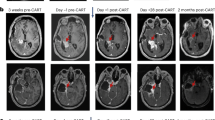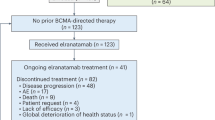Abstract
Survival for subgroups of patients with Wilms tumor (WT), such as those who suffer from relapse, is disappointing. Some patients’ treatment plans include high-dose chemotherapy (HDT) with autologous hematopoietic cell transplantation (aHCT), although proof for its benefit is lacking. To increase the level of evidence regarding children with WT receiving aHCT as consolidation of first or second remission (after first relapse), we extracted relevant data from the European Blood and Marrow Transplantation Registry concerning 69 patients. Different HDT regimens were administered, mostly either melphalan-containing (n = 34) or thiotepa-containing (n = 14). For the whole population, 5-year overall survival (OS) and event-free survival (EFS) probabilities were 0.67 (±0.06) and 0.63 (±0.06), respectively (median observation time 7.8 years); for children transplanted in first remission, OS and EFS were 0.69 (±0.09) and 0.72 (±0.08). In univariate analysis, male gender and relapse in multiple sites were associated with lower OS probabilities. The use of a given pretransplant regimen (i.e. melphalan alone versus regimens with multiple drugs) did not seem to influence EFS/OS probability after aHCT, but significantly influenced platelet engraftment (more delayed with thiotepa). We here provide further data to improve the basis for future evidence-based clinical decision-making when using HDT and aHCT in relapsed/refractory WT.
This is a preview of subscription content, access via your institution
Access options
Subscribe to this journal
Receive 12 print issues and online access
$259.00 per year
only $21.58 per issue
Buy this article
- Purchase on Springer Link
- Instant access to full article PDF
Prices may be subject to local taxes which are calculated during checkout

Similar content being viewed by others
References
Gatta G, Botta L, Rossi S, Aareleid T, Bielska-Lasota M, Clavel J, et al. Childhood cancer survival in Europe 1999–2007: results of EUROCARE-5 a population-based study. Lancet Oncol. 2014;15:35–47.
Graf N, Van Tinteren H, Bergeron C, Pein F, van den Heuvel-Eibrink MM, Sandstedt B, et al. Characteristics and outcome of stage II and III non-anaplastic Wilms’ tumour treated according to the SIOP trial and study 93-01. Eur J Cancer. 2012;48:3240–48.
Pritchard-Jones K, Bergeron C, de Camargo B, van den Heuvel-Eibrink MM, Acha T, Godzinski J, et al. Omission of doxorubicin from the treatment of stage II-III, intermediate-risk Wilms’ tumour (SIOP WT 2001): an open-label, non-inferiority, randomised controlled trial. Lancet. 2015;386:1156–64.
Gratias EJ, Dome JS, Jennings LJ, Chi YY, Tian J, Anderson J, et al. Association of chromosome 1q gain with inferior survival in favorable-histology Wilms Tumor: a report from the Children’s Oncology Group. J Clin Oncol. 2016;34:3189–94.
Spreafico F, Biasoni D, Lo Vullo S, Gandola L, D’Angelo P, Terenziani M, et al. Results of the third AIEOP cooperative protocol on Wilms tumor (TW2003) and related considerations. J Urol. 2017;5:1138–45.
Brok J, Lopez-Yurda M, Tinteren HV, Treger TD, Furtwängler R, Graf N, et al. Relapse of Wilms’ tumour and detection methods: a retrospective analysis of the 2001 Renal Tumour Study Group-International Society of Paediatric Oncology Wilms’ tumour protocol database. Lancet Oncol. 2018;19:1072–81.
Green DM, Cotton CA, Malogolowkin M, Breslow NE, Perlman E, Miser J, et al. Treatment of Wilms tumor relapsing after initial treatment with vincristine and actinomycin D. A report from the National Wilms Tumor Study Group. Pediatr Blood Cancer. 2007;48:493–9.
Malogolowkin M, Cotton CA, Green DM, Breslow NE, Perlman E, Miser J, et al. Treatment of Wilms tumor relapsing after initial treatment with vincristine, actinomycin D, and doxorubicin. A report from the National Wilms Tumor Study Group. Pediatr Blood Cancer. 2008;50:236–41.
Spreafico F, Pritchard-Jones K, Malogolowkin MH, Bergeron C, Hale J, de Kraker J, et al. Treatment of relapsed Wilms tumors: lessons learned. Expert Rev Anticancer Ther. 2009;9:1807–15.
Brok J, Pritchard-Jones K, Geller JI, Spreafico F. Review of phase I and II trials for Wilms’ tumour—can we optimise the search for novel agents? Eur J Cancer. 2017;79:205–13.
Pein F, Michon J, Valteau-Couanet D, Quintana E, Frappaz D, Vannier JP, et al. High-dose melphalan, etoposide, and carboplatin followed by autologous stem-cell rescue in pediatric high-risk recurrent Wilms’ tumor: a French Society of Pediatric Oncology study. J Clin Oncol. 1998;16:3295–301.
Kremens B, Gruhn B, Klingebiel T, Hasan C, Laws HJ, Koscielniak E, et al. High-dose chemotherapy with autologous stem cell rescue in children with nephroblastoma. Bone Marrow Transpl. 2002;30:893–8.
Campbell AD, Cohn SL, Reynolds M, Seshadri R, Morgan E, Geissler G, et al. Treatment of relapsed Wilms’ tumor with high-dose therapy and autologous hematopoietic stem-cell rescue: the experience at Children’s Memorial Hospital. J Clin Oncol. 2004;22:2885–90.
Spreafico F, Bisogno G, Collini P, Jenkner A, Gandola L, D’Angelo P, et al. Treatment of high-risk relapsed Wilms tumor with dose-intensive chemotherapy, marrow-ablative chemotherapy, and autologous hematopoietic stem-cell support: experience by the Italian Association of Pedaitric Hematology and Oncology. Pediatr Blood Cancer. 2008;51:23–8.
Hale J, Hobson R, Moroz V, Sartori P. Results of UK Children’s Cancer and Leukemia Group (CCLG) protocol for relapsed Wilms tumor (UKWR): unified relapse strategy improves outcome. In: 40th meeting of International Society of Paediatric Oncology. 2008;O154:62.
Abu-Ghosh AM, Krailo MD, Goldman SC, Slack RS, Davenport V, Morris E, et al. Ifosfamide, carboplatin and etoposide in children with poor-risk relapsed Wilms’ tumor: a Children’s Cancer group report. Ann Oncol. 2002;13:460–9.
Ha TC, Spreafico F, Graf N, Dallorso S, Dome JS, Malogolowkin M, et al. An international strategy to determine the role of high dose therapy in recurrent Wilms’ tumour. Eur J Cancer. 2013;49:194–210.
Garaventa A, Hartmann O, Bernard JL, Zucker JM, Pardo N, Castel V, et al. Autologous bone marrow transplantation for pediatric Wilms’ tumour: the experience of the European Bone Marrow Transplantation Solid Tumour Registry. Med Pediatr Oncol. 1994;22:11–4.
Malogolowkin MH, Hemmer MT, Le-Rademacher J, Hale GA, Metha PA, Smith AR, et al. Outcomes following autologous hematopoietic stem cell transplant for patients with relapsed Wilms’ tumor: a CIBMTR retrospective analysis. Bone Marrow Transpl. 2017;52:1549–55.
van den Heuvel-Eibrink MM, Hol JA, Pritchard-Jones K, van Tinteren H, Furtwängler R, Verschuur AC, et al. Position paper: rationale for the treatment of Wilms tumour in the UMBRELLA SIOP-RTSG 2016 protocol. Nat Rev Urol. 2017;14:743–52.
Kaplan EL. Nonparametric estimation from incomplete observations. J Am Stat Assoc. 1958;53:457–81.
Cox D. Regression models and life table. J R Stat Soc Ser B Stat Methodol. 1972;34:187–220.
Wilcoxon F. Individual comparisons by ranking methods. Biom Bull. 1945;6:80–3.
Kalbfleisch JD, Prentice RL. Wiley Series in Probability and Statistics. The statistical analysis of failure time data. 2nd ed. 2002; John Wiley and Sons.
Gray RJ. A class of k-sample tests for comparing the cumulative incidence of a competing risk. Ann Stat. 1988;16:1141–54.
Dome JS, Graf N, Geller JI, Fernandez CV, Mullen EA, Spreafico F, et al. Advances in Wilms tumor treatment and biology: progress through international collaboration. J Clin Oncol. 2015;33:2999–3007.
Mavinkurve-Groothuis AM, van den Heuvel-Eibrink MM, Tytgat GA, van Tinteren H, Vujanic G, Pritchard-Jones KL, et al. Treatment of relapsed Wilms tumour (WT) patients: experience with topotecan. A report from the SIOP Renal Tumour Study Group (RTSG). Pedia Blood Cancer. 2015;62:598–602.
Hol JA, van den Heuvel-Eibrink MM, Graf N, Pritchard-Jones K, Brok J, van Tinteren H, et al. Irinotecan for relapsed Wilms tumor in pediatric patients: SIOP experience and review of the literature-A report from the SIOP Renal Tumor Study Group. Pediatr Blood Cancer. 2018;65. https://doi.org/10.1002/pbc.26849.
Dome JS, Liu T, Krasin M, Lott L, Shearer P, Daw NC, et al. Improved survival for patients with recurrent Wilms tumor: the experience at St. Jude Children’s Research Hospital. Hosp J Pediatr Hematol/Oncol. 2002;24:192–8.
Spreafico F, Pritchard-Jones K, Bergeron C, de Kraker, Dallorso S, Graf N. Value and difficulties of a common European strategy for recurrent Wilms’ tumor. Expert Rev Anticancer Ther. 2009;9:693–6.
Wegert J, Vokuhl C, Ziegler B, Ernestus K, Leuschner I, Furtwängler R, et al. TP53 alterations in Wilms tumour represent progression events with strong intratumour heterogeneity that are closely linked but not limited to anaplasia. J Pathol Clin Res. 2017;3:234–48.
Acknowledgements
List of contributing centers: IRRCS Ospedale Pediatrico Bambino Gesù Rome; Institute Curie Paris; University of Helsinki Hospital for Children & Adolescents; Clinica di Oncoematologia Pediatrica Dipartimento di Pediatria Padova; Our Lady’s Children’s Hospital Crumlin Dublin; Hebron hospital Barcelona; North Trent BMT Programme Sheffield Teaching Hospitals NHS Trust/Sheffield Children’s Hospital; Cape of Hope Wroclaw Medical University; Klinikum der Johann-Wolfgang Goethe Universitaet Frankfurt_am_Main; University Hospital Bern Paediatric Hematology/Oncology Bern; Inst. Português de Oncologia do Porto BMT Unit; Bristol Royal Hospital for Children Dept. of Paediatric Oncology/BMT; St. Anna Kinderspital Stem Cell Transplantation Unit Vienna; Edmond & Lily Safra Children’s Hospital Paediatric Hemato Oncology & BMT Tel-Hashomer; Pediatric University Teaching Hospital BMT Unit II Children’s Clinic Bratislava; Service d’Hématologie et d’Oncologie pédiatrique CHU Hautepierre Strasbourg; Turku University Hospital TD7 (Stem Cell Transplant Unit); Chu Estaing Service d’hématologie clinique Adulte et pédiatrie Clermont, University Hospital “Queen Johanna-Isul” Sofia, Poznan University of Medical Sciences Department of Pediatric Onology, Hematology & HSCT, The Children’s Hospital at Westmead Sydney; Clínica Universitaria de Navarra Pamplona; Pediatric Oncology Unit, Fondazione IRCCS Istituto Nazionale dei Tumori, Milano, Italy; Istituto Giannina Gaslini, Genova, Italy.
Author information
Authors and Affiliations
Consortia
Corresponding author
Ethics declarations
Conflict of interest
The authors declare that they have no conflict of interest.
Additional information
Publisher’s note Springer Nature remains neutral with regard to jurisdictional claims in published maps and institutional affiliations.
Rights and permissions
About this article
Cite this article
Spreafico, F., Dalissier, A., Pötschger, U. et al. High dose chemotherapy and autologous hematopoietic cell transplantation for Wilms tumor: a study of the European Society for Blood and Marrow Transplantation. Bone Marrow Transplant 55, 376–383 (2020). https://doi.org/10.1038/s41409-019-0661-7
Received:
Revised:
Accepted:
Published:
Issue Date:
DOI: https://doi.org/10.1038/s41409-019-0661-7
This article is cited by
-
Wilms tumour
Nature Reviews Disease Primers (2021)



